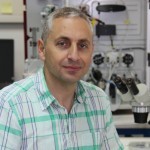New Strategy for HIV
In light of the limitations of existing drugs for AIDS:
Researchers at the Technion Faculty of Biology offer a new strategy to combat the HIV-1 virus
The AIDS epidemic continues to take the lives of millions around the world. Despite the resistance of the body cells that are attacked, and despite the use of dedicated drugs, HIV-1 virus manages to survive and reproduce in the living cell and is displaying increasing resistance.
In light of the partial failure of existing drugs, the strategy of medical research in this field is changing: instead of focusing on the proteins of the virus (and the development of drugs that target them), the new strategy focuses on the interactions of the virus proteins with the host cell.
This strategy is far more effective, since the virus cannot survive and reproduce without relying on the cellular mechanisms of the host cell. However, the new strategy also has its weaknesses.
Assistant Prof. Akram Alian of the Technion Faculty of Biology explains that when the virus encounters a barrier on its way into a cell, it looks for ‘detours’ that will enable it to take advantage of the cell nevertheless. Since there is redundancy in the host cell – various mechanisms leading to the same operation – the virus may exploit a self-mutation that could enable it to make use of that detour. “Our hypothesis is that the redundancy in the cellular pathways may represent a survival mechanism that allows the virus to take advantage of a wide variety of similar processes,” says Assistant Prof. Alian. “The virus can use these detours when the favored route is blocked by natural cellular mechanisms or artificial drugs and under other circumstances in which it is better for the virus to circumvent the obstacles of the cellular environment and the various stages of replication.”
Assistant Prof. Alian and research assistant Dr. Ailie Marx present an abstract of the innovative concept in a paper that was published in the May issue of the Journal of Virology. Janine McCaughey, a visiting student in the lab, illustrates this idea with a drawing of HIV-1 as an octopus whose arms represent takeover paths. The illustration appears on the cover of the issue (http://jvi.asm.org/content/89/12.cover-expansion).
An earlier article, published in the journal Cell Structure in October 2014, reviewed a new approach to AIDS research developed by scientists at Assistant Prof. Alian’s laboratory. The researchers conducted a comparison of an important viral protein (integrase) that exists in both HIV-1 and FIV, the AIDS pathogen in cats, and discovered new differences
that could aid in the understanding and prediction of the development of resistance. With both viruses, the integrase inserts the viral DNA into the DNA of the infected cell, and then replicates itself in a manner that enables it to spread throughout the body.
“The virus is a kind of Trojan horse, which uses the host’s genome in order to replicate,” explains Assistant Prof. Alian. “Now we are studying this issue in depth and trying to develop this idea of ‘multiple route reproduction of the HIV virus,’ as a new strategy in the treatment of AIDS.”



